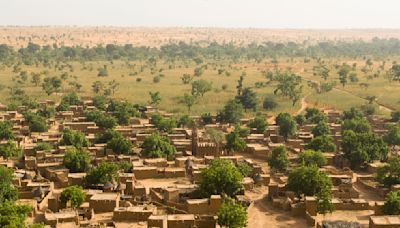Search results
The Sahara covers large parts of Algeria, Chad, Egypt, Libya, Mali, Mauritania, Niger, Western Sahara and Sudan, and parts of southern Morocco and Tunisia. It covers 9 million square kilometres (3,500,000 sq mi), 31% of the African continent.
- Overview
- Physiography
The Sahara exhibits great climatic variability within its borders, with two major climatic regimes differentiating along a north-south axis: the desert’s northern latitudes are arid subtropical and have two rainy seasons, while the southern ones, although also arid, are more tropical and have only one rainy season. The southern reaches of the Sahara end in the Sahel, a semiarid buffer zone that separates the desert from the more temperate savanna biomes beyond. A number of other factors affect climatic variability within the Sahara as well: topography does so, as do ocean currents, the latter of which are responsible for the slightly cooler and more humid conditions found on the desert’s western margins. Some scientists estimate that the Sahara became arid about two to three million years ago, while others contend that it happened before this.
Read more below: None
None
Read more about the Sahel.
How did the Sahara get its name?
In Arabic the Sahara is called Al-Ṣaḥrāʾ al-Kubrā, or “the Great Desert.” The Arabic word ṣaḥrāʾ simply means “desert,” and its plural form, ṣaḥārāʾ, is where the northern African desert gets its Anglicized name. The word ṣaḥrāʾ shares its roots with the Arabic word aṣḥar, which translates to “desert-like” and specifically connotes the yellowish red color that characterizes the Sahara’s sandy expanses.
The principal topographical features of the Sahara include shallow, seasonally inundated basins (chotts and dayas) and large oasis depressions; extensive gravel-covered plains (serirs or regs); rock-strewn plateaus (hammadas); abrupt mountains; and sand sheets, dunes, and sand seas (ergs). The highest point in the desert is the 11,204-foot (3,415-metre) summit of Mount Koussi in the Tibesti Mountains in Chad. The lowest, 436 feet (133 metres) below sea level, is in the Qattara Depression of Egypt.
The name Sahara derives from the Arabic noun ṣaḥrāʾ, meaning desert, and its plural, ṣaḥārāʾ. It is also related to the adjective aṣḥar, meaning desertlike and carrying a strong connotation of the reddish colour of the vegetationless plains. There are also indigenous names for particular areas—such as the Tanezrouft region of southwestern Algeria and the Ténéré region of central Niger—which are often of Berber origin.
The Sahara sits atop the African Shield, which is composed of heavily folded and denuded Precambrian rocks. Because of the stability of the shield, subsequently deposited Paleozoic formations have remained horizontal and relatively unaltered. Over much of the Sahara, these formations were covered by Mesozoic deposits—including the limestones of Algeria, southern Tunisia, and northern Libya, and the Nubian sandstones of the Libyan Desert—and many of the important regional aquifers are identified with them. In the northern Sahara, these formations are also associated with a series of basins and depressions extending from the oases of western Egypt to the chotts of Algeria. In the southern Sahara, downwarping of the African Shield created large basins occupied by Cenozoic lakes and seas, such as the ancient Mega-Chad. The serirs and regs differ in character in various regions of the desert but are believed to represent Cenozoic depositional surfaces. A prominent feature of the plains is the dark patina of ferromanganese compounds, called desert varnish, that forms on the surfaces of weathered rocks. The plateaus of the Sahara, such as the Tademaït Plateau of Algeria, are typically covered with angular, weathered rock. In the central Sahara, the monotony of the plains and plateaus is broken by prominent volcanic massifs—including Mount ʿUwaynat and the Tibesti and Ahaggar mountains. Other noteworthy formations include the Ennedi Plateau of Chad, the Aïr Massif of Niger, the Iforas Massif of Mali, and the outcroppings of the Mauritanian Adrar region.
Britannica Quiz
Geography of Africa Quiz
Sand sheets and dunes cover approximately 25 percent of the Sahara’s surface. The principal types of dunes include tied dunes, which form in the lee of hills or other obstacles; parabolic blowout dunes; crescent-shaped barchans and transverse dunes; longitudinal seifs; and the massive, complex forms associated with sand seas. Several pyramidal dunes in the Sahara attain heights of nearly 500 feet, while draa, the mountainous sand ridges that dominate the ergs, are said to reach 1,000 feet. An unusual phenomenon associated with desert sands is their “singing” or booming. Various hypotheses have been advanced to explain the phenomenon, such as those based upon the piezoelectric property of crystalline quartz, but the mystery remains unsolved.
Oct 29, 2021 · Covering a massive area of 9,200,000 sq. km, the Sahara Desert is considered the world’s largest hot desert and the third most extensive desert after the polar deserts of Antarctica and the northern Arctic. The Sahara Desert encompasses a major portion of North Africa, occupying about 31% of the entire African continent.
- Diptarka Ghosh
Feb 5, 2024 · However, at 3.6 million square miles, the Sahara absolutely is the biggest hot desert in the world, by a wide margin: It’s more than three times the size of the next biggest desert (the Great Australian Desert) and almost quadruple the size of the Arabian Desert.
What Really Turned the Sahara Desert From a Green Oasis Into a Wasteland? 10,000 years ago, this iconic desert was unrecognizable. A new hypothesis suggests that humans may have tipped the...
Aug 12, 2019 · The Sahara Desert is located in the northern portion of Africa and covers over 3,500,000 square miles (9,000,000 sq km) or roughly 10% of the continent. It is bounded in the east by the Red Sea and it stretches west to the Atlantic Ocean.
Jun 16, 2023 · The Sahara Desert presents a stark yet diverse landscape characterized by vast, sandy dunes, rocky plateaus, scattered oases, and sparse vegetation, all under a relentless, blazing sun. Although the Sahara Desert is often depicted as a vast sea of rolling sand dunes, in reality, sandy deserts comprise just about 20-25% of the Sahara.
getyourguide.com has been visited by 1M+ users in the past month
Convenient and flexible cancellation up to 24 hours before your tour — no questions asked. Make the most of your time. Plan a Sahara desert itinerary with unforgettable experiences.




